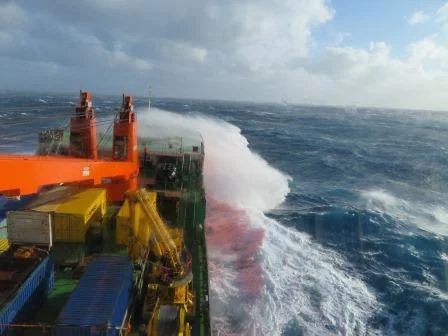Antarctic Blog
27 January 2017
A storm at the latitude of the infamous "Furious Fifties"
by Julia Schmale
After four weeks at sea, we finally get to Hobart. Dolphins jump around the ship as if they were welcoming us. The weather is exceptional, and we are all looking forward for a bit of rest on land. Fiona and Markus are leaving the team, Andrea and Silvia are now joining. Time is short, however, and the old and new ACE-SPACE team work hard to get the lab container ready for the next leg. We are able to repair the SPIN instrument to measure IN, we replace our online gas chromatograph for isoprene, and install a NAIS and an APi-TOF to focus on new particle formation events during the second leg when we go through sea ice.
There is only little time for us to enjoy Hobart, but at least we managed to see Wallabies, small Tasmanian kangaroos. On Sunday, 22nd of January, we sail again. Not even after 24 hours at sea, we get into the first serious storm. It’s only the edge that we are passing, but that’s enough to test our container lab for real. All decks are closed and we have to wait inside the ship. Waves are up to 15 meters high, the foredeck often disappears into the ocean, while the sea spray completely hides our container. Admittedly, we are a bit nervous if all will hold and whether water will come into the inlets. Fortunately, we can observe the measurements comfortably from inside the ship thanks to the network that we installed. All goes well and the next morning we are able to access our lab again.
Shortly after the storm we start passing the polar front. Just by looking at the CPCs we can tell how the air masses change. Gradually, we go from roughly 600 particles per cubic centimeter (p/cc) to less than 100 p/cc. We observe a persistent particle mode at 30 nm for two days. Now we are only half a day away from the pack ice.
back to all blog entries
There is only little time for us to enjoy Hobart, but at least we managed to see Wallabies, small Tasmanian kangaroos. On Sunday, 22nd of January, we sail again. Not even after 24 hours at sea, we get into the first serious storm. It’s only the edge that we are passing, but that’s enough to test our container lab for real. All decks are closed and we have to wait inside the ship. Waves are up to 15 meters high, the foredeck often disappears into the ocean, while the sea spray completely hides our container. Admittedly, we are a bit nervous if all will hold and whether water will come into the inlets. Fortunately, we can observe the measurements comfortably from inside the ship thanks to the network that we installed. All goes well and the next morning we are able to access our lab again.
Shortly after the storm we start passing the polar front. Just by looking at the CPCs we can tell how the air masses change. Gradually, we go from roughly 600 particles per cubic centimeter (p/cc) to less than 100 p/cc. We observe a persistent particle mode at 30 nm for two days. Now we are only half a day away from the pack ice.
back to all blog entries


